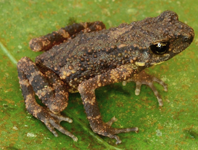Abstract
High mountain ranges such as the Tibetan Plateau with an average altitude above 4500 m are topographically complex formations. Elevational gradients, physiographic diversity and climatic heterogeneity have led to highly biodiverse ecosystems in these regions. Mountain ranges can be seen as cradles of evolution and harbour, due to their unique characteristics, a high number of highly adapted species. At the same time these areas are hard to access and therefore taxonomic information is limited. Here we describe a new Acricotopus (Diptera: Chironomidae: Orthocladiinae) larval morphotype occurring in lakes and ponds of differing salinity and water depths located on the Southern and Central Tibetan Plateau. The description is based on larvae and their genetics (ribosomal 18S, 28S and mitochondrial COI sequences) collected from a shallow pond in close proximity to the large saline lake Selin Co. Larvae of Acricotopus indet. morphotype incurvatus are characterized by a mentum with a cluster of lateral teeth, partially folded inwards, a mandible with a toothed lobe in addition to four inner teeth and a sclerotized plate positioned behind the mentum. Up to now, these morphological features have only been found in early instars of other Acricotopus species. The proposed morphotype name is inspired by the peculiar form of the mentum.
References
Abarenkov, K., Tedersoo, L., Nilsson, R.H., Vellak, K., Saar, I., Veldre, V., Parmasto, E., Prous, M., Aan, A., Ots, M., Kurina, O., Ostonen, I., Jogeva, J., Halapuu, S., Poldmaa, K., Toots, M., Truu, J., Larsson, K.-H. & Koljalg, U. (2010) PlutoF-a Web Based Workbench for Ecological and Taxonomic Research, with an Online Implementation for Fungal ITS Sequences. Evolutionary Bioinformatics, 6, 189–196.
https://doi.org/10.4137/EBO.S6271
Andersen, T., Cranston, P.S. & Epler, J.H. (2013) Chironomidae of the Holarctic Region – Keys and Diagnoses – Larvae. Entomologiska Sällskapet i Lund, Lund, 573 pp.
Ashe, P. & O’Connor, J.P. (2012) A world catalogue of Chironomidae (Diptera). Part 2. Orthocladiinae. Irish Biogeographical Society, Dublin, Ireland, Volume 2, 573 pp.
Benson, D.A., Karsch-Mizrachi, I., Lipman, D.J., Ostell, J. & Sayers, E.W. (2008) GenBank. Nucleic Acids Research, 37, 26–31.
https://doi.org/10.1093/nar/gkn723
Brodersen, K.P. & Lindegaard, C. (1999) Mass occurrence and sporadic distribution of Corynocera ambigua Zetterstedt (Diptera, Chironomidae) in Danish lakes. Neo- and palaeolimnological records. Journal of Paleolimnology, 22 (1), 41–52.
https://doi.org/10.1023/A:1008032619776
Brooks, S.J., Langdon, P.G. & Heiri, O. (2007) The identification and use of Palaearctic Chironomidae larvae in palaeoecology. Quaternary Research Association, London, 276 pp.
Cranston, P.S., Hardy, N.B. & Morse, G.E. (2011) A dated molecular phylogeny for the Chironomidae (Diptera). Systematic Entomology, 37 (1), 172–188.
https://doi.org/10.1111/j.1365-3113.2011.00603.x
Ekrem, T., Stur, E., Orton, M.G. & Adamowicz, S.J. (2018) DNA barcode data reveal biogeographic trends in Arctic non-biting midges. Genome, 61 (11), 787–796.
https://doi.org/10.1139/gen-2018-0100
Folmer, O., Black, M., Hoeh, W., Lutz, R. & Vrijenhoek, R. (1994) DNA primers for amplification of mitochondrial cytochrome c oxidase subunit I from diverse metazoan invertebrates. Molecular Marine Biology and Biotechnology, 3 (5), 294–299
Gouy, M., Guindon, S. & Gascuel, O. (2010) SeaView Version 4: A Multiplatform Graphical User Interface for Sequence Alignment and Phylogenetic Tree Building. Molecular Biology and Evolution, 27 (2), 221–224.
https://doi.org/10.1093/molbev/msp259
Hamerlík, L., Christoffersen, K.S. & Brodersen, K.P. (2010) Short comment on chironomid assemblages and stratigraphy of high altitude lakes from Tibet. CHIRONOMUS Journal of Chironomidae Research, 23, 20–24.
https://doi.org/10.5324/cjcr.v0i23.661
Ingvason, H.R., Ólafsson, J.S. & Gardarsson, A. (2004) Food selection of Tanytarsus gracilentus larvae (Diptera: Chironomidae): An analysis of instars and cohorts. Aquatic Ecology, 38 (2), 231–237.
https://doi.org/10.1023/B:AECO.0000032053.67992.03
Katoh, K., Rozewicki, J. & Yamada, K.D. (2017) MAFFT online service: multiple sequence alignment, interactive sequence choice and visualization. Briefings in bioinformatics.
https://doi.org/10.1093/bib/bbx108
Laug, A., Engels, S., Hamerlík, L., Turner, F., Wang, J. & Schwalb, A. (2018) “Orthocladiinae type K” A special group of chironomid morphotypes from the Tibetan Plateau. Available from:https://doi.org/10.13140/RG.2.2.21480.16644 (accessed 06 May 2019)
Morse, G.E. & Normark, B.B. (2006) A molecular phylogenetic study of armoured scale insects (Hemiptera: Diaspididae). Systematic Entomology, 31 (2), 338–349.
https://doi.org/10.1111/j.1365-3113.2005.00316.x
Plank, A. (2010) Chironomid-based inference models for Tibetan lakes aided by a newly developed chironomid identification key. Freie Universität Berlin, Berlin, 69 pp.
[https://refubium.fu-berlin.de/handle/fub188/8531]
Reiss, F. (1968) Neue Chironomiden - Arten (Diptera) aus Nepal. In: Hellmich, W. (Eds.), Khumbu Himal 3, Universitätsverlag Wagner, Innsbruck, pp. 55–73.
Staiber, W. (2004) Molecular evolution of homologous gene sequences in germline-limited and somatic chromosomes of Acricotopus. Genome, 47 (4), 732–741.
https://doi.org/10.1139/g04-026
Stamatakis, A. (2014) RAxML version 8: a tool for phylogenetic analysis and post-analysis of large phylogenies. Bioinformatics, 30 (9), 1312–1313.
https://doi.org/10.1093/bioinformatics/btu033
Whiting, M.F., Carpenter, J.C., Wheeler, Q.D. & Wheeler, W.C. (1997) The Strepsiptera problem: phylogeny of the holometabolous insect orders inferred from 18S and 28S ribosomal DNA sequences and morphology. Systematic Biology, 46 (1), 1–68.
https://doi.org/10.1093/sysbio/46.1.1
Zelentsov, N.I. (1989) New orthoclad species of Cricotopus van der Wulp and metamorphose of Acricotopus longipalpus Reiss (Diptera, Chironomidae) from Pamirs region. In: Shilova, A.I., Mikrjakov, W.R. & Sokolova, H.J. (Eds.), Biology, systematics and functional morphology of freshwater animals, Nauka, Leningrad, pp. 55–73.
Zelentsov, N.I. (1993) A new orthoclad species of the genus Acricotopus Kieffer (Diptera, Chironomidae) from the region beyond the arctic circle. Proceedings of the Institute of Biology of Inner Waters, 68 (71), 133–146.
Zhang, R. & Wang, X. (2004) A review of the genus Acricotopus Kieffer (Diptera: Chironomidae) in China. Insect Science, 11 (4), 285–291.

